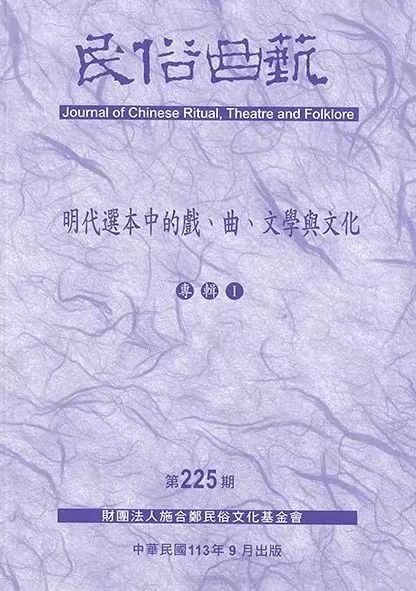
目录
前言(汪詩珮)
[專輯:研究論文]
Do the Parts Add Up? Textual Systems and Segments of Sijie Ji (The Four Seasons) in Ming Anthologies / Tan Tian Yuan
晚明曲類選本「三欄併讀」初探:以《琵琶記》、《三國記》選齣為例 / 汪詩珮
晚明曲選《詞珍雅調》的編刻策略與書籍特色 / 陳志勇
Linking the World of Performative Texts: The Interplay between Popular Songs and Dramas in Late Ming Qu Anthologies / Chen Jiani
論晚明曲選《怡春錦》之編選理念與時代特色 / 林芷瑩
[研究論文]
傳播偏向視角下民俗文化的傳承力量:以「臨水夫人信仰」為例 / 陳怡蓁
摘要
Tan Tian Yuan. “Do the Parts Add Up? Textual Systems and Segments of Sijie Ji (The Four Seasons) in Ming Anthologies.” Journal of Chinese Ritual, Theatre and Folklore 225 (2024.9): 17-57.
陳靝沅。〈聚零為整?明代曲選中《四節記》的文本系統與零散文本〉。《民俗曲藝》225 (2024.9): 17-57。
Abstract
Sijie ji四節記 (The Four Seasons) is a setof four plays believed to have been composed in the mid-Ming. Each of these four plays is based on an episode related to a season in the lives of four famous literati: Du Fu (spring), Xie An (summer), Su Shi (autumn), and Tao Gu (winter). The full texts of these plays are no longer extant, but because they were widely popular during the Ming dynasty, excerpts of various shapes and forms can be found in more than twenty qu anthologies dating from as early as 1553. In other words, Sijie ji is a lost work, of which only certain parts are preserved, and exclusively so, through anthologies. How, for a work whose partial survival is closely connected to anthologies, do we approach this body of disparate, anthologized drama parts that all appear to be associated with Sijie ji? This paper explores the significance of reading these segments of Sijie ji not necessarily as parts of an elusive whole but instead as individual, meaningful textual units belonging to more than one textual system; it also considers the role of anthologies in textual relations and the circulation of knowledge within qu texts and across various genres.
汪詩珮。〈晚明曲類選本「三欄併讀」初探:以《琵琶記》、《三國記》選齣為例〉。《民俗曲藝》225 (2024.9): 59-124。
Wang Shih-pe. “Exploring the ‘Triple-Register-Reading Strategy’ in Late Ming Qu Anthologies: Selections from Pipa Ji and Sanguo Ji.” Journal of Chinese Ritual, Theatre and Folklore 225 (2024.9): 59-124.
Abstract
本文以晚明萬曆時期的曲類選本為論述主題,針對三欄式選本進行「三欄併讀」的探索,解析欄位文本彼此的隱然聯繫、潛在的編選策略、意在言外的閱讀方式。論述將以《琵琶記》、《三國記》選齣為例,探究「三欄皆為戲、曲」的討論,提出各欄內容之間的組合,並非隨意性、無規則者,而是不乏暗藏機心、埋有隱喻,富有聯想遐思者。本文主張,三欄併讀法更倚賴以「頁」為大單位,「欄」、「欄」之間為小單位,形成板塊式的視覺意象,其間「樂府」與「隱語」的關係,實乃元末南方曲家之遺風與深化。透過選齣與小曲的三欄組合,打碎分別閱讀所得之意義結構,產生新的歧義與隱意,為熟悉劇、曲的讀者帶來全新的體會,堪稱是一種「翻轉閱讀法」。
陳志勇。〈晚明曲選《詞珍雅調》的編刻策略與書籍特色〉。《民俗曲藝》225 (2024.9): 125-52。
Chen Zhiyong. “Editorial Strategies and Book Features of the Late Ming Qu Anthology Cizhen Yadiao.” Journal of Chinese Ritual, Theatre and Folklore 225 (2024.9): 125-52.
Abstract
《詞珍雅調》是萬曆初年南京書坊胡東塘堂編刻的一部體量龐大的曲選。根據書籍形態來看,全書九集或存在分集單獨發行,再重製目錄、重編頁碼、合裝冠名《詞珍雅調》再出版的過程。此書建構起以「曲」為中心的編輯理念,散曲與劇曲、南曲與北曲、民歌小調與文人歌詞兼收,呈現出鮮明的為市井歌唱之用的「歌冊曲庫」性質。《詞珍雅調》以「情景分類法」為編纂原則,按不同生活場景分門別類編排曲詞,最大程度滿足讀者「按需找曲」的閱讀訴求。這種文本特色和選曲傾向的形成,很大程度與晚明時期南京城裡的市井歌樓流行「聽歌娛曲」的文化消費時尚有着直接的關係。從書籍史和戲曲史結合的角度審視《詞珍雅調》,可為晚明時期曲選的編刻和曲壇變遷問題的研究提供新的思路。
Chen Jiani. “Linking the World of Performative Texts: The Interplay between Popular Songs and Dramas in Late Ming Qu Anthologies.” Journal of Chinese Ritual, Theatre and Folklore 225 (2024.9): 153-90.
陳佳妮。〈鏈接表演文本的世界:晚明曲選中時曲小調與戲曲的互動〉。《民俗曲藝》225 (2024.9): 153-90。
Abstract
Popular songs, which flourished in late Ming China, were often selected and juxtaposed with play excerpts in multi-register qu anthologies. Their pages were divided into two or three horizontal panels (i.e., registers), each filled with different content and genres, a practice that cultivated innovative modes of editing, printing, and reading. The association of popular songs with the broader dramatic tradition is highlighted not only through their shared tune titles and anthological space, but also via textual circulation and performative discourse. Popular songs represented theatrical plotlines or figures through multiple forms and perspectives, shedding new light on the original plays. Their varied interpretations often corresponded with changing social realities and ethical values that can also be observed in historical records and prescriptive writings throughout the Ming dynasty. Popular songs recapitulating dramatic scenes are often arranged into groups. Their wide circulation in different qu anthologies called for creative editorial strategies such as applying unified structures that belonged to a long-established oral tradition. Framing devices included, but were not limited to, organizing a group of songs on a fixed chronological topic, such as the “five watches of the night” or the changing position of the moon outside the gauze window over the night. The group of songs, focusing on different dramatic moments and being framed within a unified framework, formed an independent song sequence that transmitted theatrical knowledge and evoked association and discourse among songs sharing similar concerns. The final type of popular song discussed in this article concerns the performers of the plays, most of whom were also singers of popular songs. The tune of Shuahai’er often likened courtesans from different regions to heroines of various plays, exemplifying diverse regional dramatic tastes. The mix of ornate dramatic language with vernacular and even vulgar dictions created an effect of improvised performance in private settings that evoked the aesthetical experience of enjoying theatrical performances and elicited intimate interaction with female performers. The interplay between songs and dramas creates a world of knowledge, entertainment, and connoisseurship that transcends the boundaries of literary composition and oral improvisation, originals and reproductions, as well as performativity and genuineness.
林芷瑩。〈論晚明曲選《怡春錦》之編選理念與時代特色〉。《民俗曲藝》225 (2024.9): 191-231。
Lin Chih-ying. “Exploring the Editorial Philosophy and Contemporaneity of the Late Ming Qu Anthology Yichun Jin.” Journal of Chinese Ritual, Theatre and Folklore 225 (2024.9): 191-231.
Abstract
本文通過晚明曲選《怡春錦》的〈序〉文段落,分由幾個不同的面向探討此書的編選理念及表現的時代意涵。此書主收明人劇作,並為此在〈序〉文中特別說明,印證「元之後,麗曲實多」,作為一種廣告與宣傳,建立了「我明」劇作的主體性。第二部分則論《怡春錦》的選劇標準,從具體作品可以看出既有符合舞臺演出的「臺本」,也有案頭閱讀的「墨本」,編選者並未以齊一標準進行刪定,同時滿足了讀者閱讀、歌者清唱、觀眾賞劇等不同面向的需求,在「文人型」選本中頗顯特殊。
而全書首卷非常集中地收錄男女歡會的情節,在〈序〉文中以《詩經》為宗,但更為正面地宣示「首麗情」的正當性,恰正與晚明縱欲風潮相映。此書除了在〈序〉文中以答客問的辯證方式指引讀者發現自己編排的用心外,也以每齣配圖、配詞的方式來凸顯對此集的看重,配詞對全劇的風情節摘引、改寫顯現編者的文字參與;並以不同書體手書上版,展示了刊印上的別出心裁。「幽期寫照禮集」以《西廂記•踐約》對春情加以渲染,據此開展全集中的風月情色,「弋陽雅調」所收散齣除聲腔的特色,更以情人、夫妻分離、失和的情節與首集的麗情相對,令全書的對稱、對照更加飽滿周全,塑造了《怡春錦》在晚明戲曲選本中獨樹一幟的特殊地位。
陳怡蓁。〈傳播偏向視角下民俗文化的傳承力量:以「臨水夫人信仰」為例〉。《民俗曲藝》225 (2024.9): 233-81。
Chen I-chen. “The Inheritance Power of Folklore Culture as Seen from the Perspective of ‘The Bias of Communication’: A Case Study of the Cult of Lady Linshui.” Journal of Chinese Ritual, Theatre and Folklore 225 (2024.9): 233-81.
Abstract
「臨水夫人(陳靖姑)信仰」是盛行於閩臺地域的民俗文化,傳承歷史已有千年之久。究其延續千年之原因,本文以哈羅德•伊尼斯(Harold Innis)提出的「傳播偏向論」為基礎,分析呈現臨水夫人信仰的不同傳播媒介如何為此民俗文化帶來傳承的力量。據筆者赴福建古田、福州田野調查的結果,祭祀科儀、戲曲表演、口傳心授、節慶風俗是傳播臨水夫人信仰的重要媒介,分別為此文化構建具集體意義、民間性和引導性、生活場景式、融入在地的傳播特徵。前述媒介表現較強時間偏向的同時,背後與空間偏向性的平面媒介展開融合並達成時空平衡是最終為臨水夫人信仰傳播內容帶來統一性和多樣性兼具的原因,且在多方文化參與者的協同作用下為此文化傳承帶來堅守傳統與創新發展的深層力量。
(本資訊經出版方授權發佈。)

